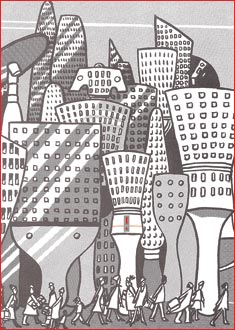Paint Memorabilia Corner
Custodians of Our Past
Painting in Partnership has been collecting and rescuing paint memorabilia since 1990.
Painting is a field of human endeavor that has existed since the caveman. It grows out of a need for people to personalize their living space, make it meaningful and expressive of who they are.
Over time, tools have evolved and paint mediums have become much more sophisticated and complex. Painting belongs to human history! As an extension of our role as Custodians of the Past, Painting in Partnership sees it as important to preserve paint memorabilia and tell the stories associated with those items.
This Paint Memorabilia Corner is the depository for the stories and pictures of some of the items in our collection.
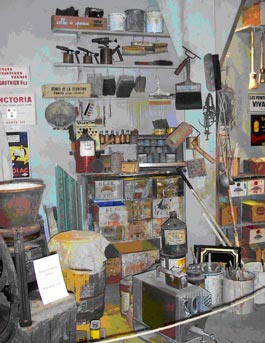
“Paint Shop” at the Paris Paint Museum.
Can You Spot the Calcimine Brush?
A Calcimine Brush from the 1920’s
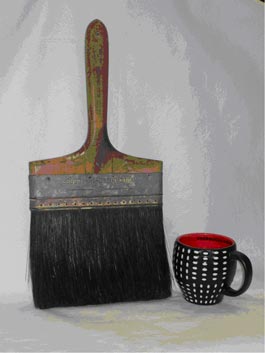
Popeye’s Own Brush
Calcimine was a precursor to latex paint and was only applied by brush. It was also known as Kalsomine or distemper paint. It was made out of dried calcium carbonate, water, glue and colorants. Calcimine was used as a wash for walls and ceilings. It was commonly used throughout the 19th century and the first third of the 20th century. It was an inexpensive way of freshening up a room.
The Calcimine brush we are featuring is 17″ long. The handle alone is 9″ and the bristles, a good 6″. It was a great workout tool to build up Popeye forearms!
In 2000, Mario Guertin, owner of Painting In Partnership, had the opportunity to represent the United States at an international painting contractor conference in Paris. During that trip, Mario met the founder of the Painting Museum in Paris. Knowing of Mario’s interest in old paint stuff, he gave Mario many pieces of French memorabilia. Upon Mario’s return, as a thank you, Mario sent him one of his two Calcimine brushes to display at the museum in Paris.
In 2004, Mario visited the Paint Museum in Paris again. Sure enough, his Calcimine brush was proudly displayed in the paint shop portion of the museum, forever preserved, as seen in the picture at the top of the page.
Stipple Brushes from the 1920’s and 1930’s
Stipple brushes come in different shapes, material and sizes.
They were often made out of China bristles, sometimes rubber and even horse or hog hair. They were generally large in size, commonly 6 to 10 inches in length.
Shapes varied from round, square or rectangular. Smaller versions of the same brushes were made to stipple small areas, like between window casings or above doorways.
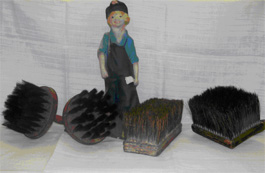
The Dutch Boy Stands Guard over Large Stipple Brushes
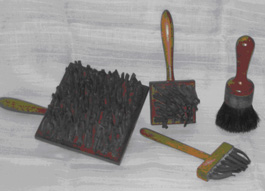
Three Sizes of Rubber Stipple Brushes to Reach any Space, and a Stencil Stipple Brush
Wall stipple brushes served a few different functions. First, before the rollers were invented, stipple brushes were sometimes used to go over wet paint to eliminate the brush marks.
More commonly, wall stipple brushes were used to produce decorative finishes with glazes or texture paints. Smaller, round and tightly packed versions were also used to force paint through the openings of stencils.
To this day, stipple brushes continue to be in vogue as a decorative finishing tool.
Antique Moisture Meters
Ascertaining the level of moisture in a substrate has long been a concern for house painters and many other trades, be it wood, plaster, concrete or drywall. There are two types of moisture meters. The most common one measures the electrical resistance of the substrate; the more moisture there is, the lower the resistance will be. This type of meter uses two electrodes that are driven into the substrate. The output of the moisture meter is translated into a scale or dial on the device. The greater the moisture level, the higher the number on the scale will be.
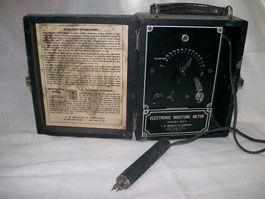
Basic Moisture Meter from the 1920s
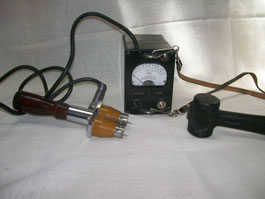
Moisture Meter from the 1940s
Here are two generations of electrical resistance moisture meters. The first one is from the 1920’s and was made by the L.R. Bradley & Co. of New York. The device used 45 volt batteries. You set the dial on the device to the maximum moisture level permitted for that substrate. A light turns on if the moisture is higher than that level.
The second moisture meter was called the “Midget Wood Meter” and was made by Weston Electrical Instruments, Corp. of Newark, New Jersey. Using the mallet provided, the pins were driven into the wood and the moisture level was displayed on the dial. This meter was from the 1940’s or 50’s era.
Newly cut wood can have moisture content of 80% or more. Painting wood when the moisture content is elevated will surely cause paint failure, because the moisture will prevent the paint from adhering to the substrate.
Painter’s Bosun’s Chair from 1920’s
The bosun’s chair (also know as Boatswain’s chair) is a device that suspends someone on a seat board held by ropes. The chair enables a worker to perform work on elevated and hard-to-reach areas. This contraption was originally developed for use on tall ships and yachts for masthead repair. It also was used to gain access to the highest elevated portions of buildings. This 19th century English engraving shows how the bosun’s chair was used by a house painter.
A reproduction of this English engraving was given to me by the gentleman who founded the Paris Painting Museum. I later found that the same engraving had been reproduced in one of the centennial editions of the Chief Paint Works’s newsletter, which is now part of our collection as well. Small world!

19th Century Engraving of Painter Using Bosun’s Chair
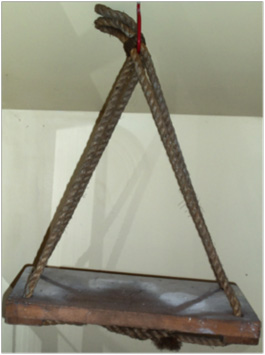
Early 20th Century Bosun’s Chair
As you can see, working off of a bosun’s chair was not a safe activity. Workers were known to occasionally fall out of the chair. Needless to say, OSHA would not approve the chair for use today, surely not without a proper harness system! The other picture shows a real-life bosun’s chair that was used in Chicago by commercial painters in the earlier part of the twentieth century. I purchased this chair from a commercial painting contractor who was closing shop after forty years in the painting business in Chicago. Lucky find indeed!
Antique Gilding Tools – 1940s
Gilding is an ancient art form. It belongs to the tradition of painting and decorating. Egyptians loved it. Romans went gaga over it. The appeal of gilding comes from the fact that it makes something look like it is made of a solid precious metal (like gold and silver for example), even though the thickness of the metal used is about one atom thick. It is made by skillfully hammering down a stack of small metal pieces.
These thin metal leaves can be applied to a wide variety of substrates like stone, metal, wood, plaster, leather, porcelain etc. They are made to adhere to the substrate by first applying some kind of adhesive substance (like a varnish). The leaves are laid down when the varnish is still tacky, thereby creating a permanent bond with the metal as the adhesive substance dries.
The tools on display in the picture are from the 1940s. They are used for traditional gilding. They are as follows:
1-Top Left: Slow-drying gilding varnish
2-Top: Three gilder’s mops (used to help flatten the leaves in place
3-Top/middle: Gilder’s Tip used to pick up metal leaves by creating static electricity from rubbing the thin bristles against one’s hair
4-Left bottom: Four Agate Burnishing Tools to bring out the sheen
5-Bottom left: Leaf Knife used to cut leaves on a gilder’s pad
6-Bottom right: Rolled Leaf Applicator
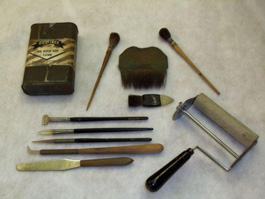
Antique Gilding Tools
European Painters from Another Era
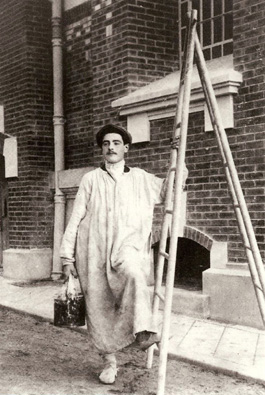

As painters, we belong to a long and deep tradition. On the left, a painter in Paris in the 1910’s. I am still looking to get my hands on a ladder like that! On the right is a photograph by Marc Riboud taken in Paris entitled the “Eiffel Tower Painter”. The picture predates the advent of the French equivalent of OSHA!







